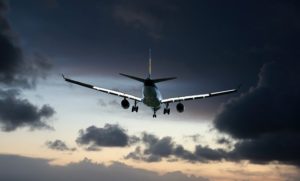Flight radar: The world of flight tracking in detail
It’s hard to imagine modern life without air travel. But how exactly do you know what’s happening in the air above you? That’s where flight radar comes in, a fascinating tool that allows you to track aircraft around the world in real time. In this blog post, we’ll take an in-depth look at flight radar and explore how it works, what it means, and the best flight radar services.
What is a flight radar?

A flight radar, also known as ADS-B (Automatic Dependent Surveillance-Broadcast), is a system for tracking aircraft in real time. It is based on data broadcast by the aircraft themselves. This data includes information such as aircraft position, speed, altitude, flight number and more. Airborne radar systems receive these signals and display them on a map that is available to the public.
How does a flight radar work?
The foundation of airborne radar is communication between the aircraft and ground stations. Here are the steps on how it works:
1. Data transmission from the aircraft
Jedes moderne Flugzeug ist mit einem Transponder ausgestattet, der ständig Daten sendet. Diese Daten enthalten Informationen über die Position des Flugzeugs, seine Geschwindigkeit, Flughöhe und Identifikationsdaten wie die Flugnummer.
2. Ground stations receive the data
All over the world, there are ground stations that receive the signals emitted by aircraft. These stations are part of the global flight tracking system.
3. Data processing and display
The data received from the ground stations is transmitted to central computers, where it is processed and displayed on a map. This map shows the current positions of the aircraft in real time.
Why is flight radar important?
The importance of airborne radar goes beyond the curiosity of watching aircraft in the sky. Here are some of the main reasons why airborne radar is important:
1. Flight tracking for travelers
For passengers, flight radar is a useful resource to check the status of their flight, learn about delays and get to the airport on time.
2. Flight safety
Flight radar is an indispensable tool for aviation safety. Air traffic controllers can monitor the positions of aircraft in real time and ensure that they fly safely away from each other.
3. Search and rescue
In the event of an emergency, airborne radar enables rapid location and rescue of aircraft in trouble.
4. Traffic Management
Flight radar helps airports and air traffic control to coordinate air traffic efficiently and avoid bottlenecks.
The best flight radar services

There are many flight radar services, both free and paid. Here are some of the best options:
1. Flightradar24
Flightradar24 is one of the most popular flight radar services in the world. The website offers an interactive map with comprehensive information about each aircraft. The free version provides basic flight tracking, while the paid version offers advanced features.
2. FlightAware
FlightAware also provides a user-friendly flight tracking platform. You can also set up custom notifications for specific flights.
3. PlaneFinder
PlaneFinder is known for its user-friendly app that is available on various platforms. The app offers not only flight tracking, but also airport and aircraft information.
4. RadarBox24
RadarBox24 is characterized by a large community that shares information about flights. The platform also provides access to historical flight data.
5. OpenSky Network
OpenSky Network is an open source airborne radar project that collects data from around the world. It is aimed at technology enthusiasts and developers.
The future of flight tracking
Flight tracking technology is constantly evolving. Future developments could improve the accuracy of the data and provide even more precise information about aircraft in real time. In addition, drones could also be integrated into flight radar systems.
Conclusion
Airborne radar is a fascinating tool that offers us insights into the world of air traffic. It is not only useful for travelers, but also for the safety and efficiency of air traffic. With the best flight radar services, you can track aircraft all over the world and learn more about the fascinating world of aviation. Try some of these services and explore the sky from your computer or smartphone.
The technology behind flight radar

The technology behind airborne radar is impressive and complex. It is based on a combination of systems that work together to provide accurate information about aircraft in the air. One of the key elements is the ADS-B transponder that every modern aircraft carries. This transponder continuously transmits signals that are received by ground stations. These ground stations are distributed around the globe and form a network that captures the signals.
The signals received contain a wide range of information, including the aircraft identifier, current position, altitude, speed and even the planned flight path. This data is collected in real time and forwarded to central servers, which process it. The processing includes updating aircraft positions on a map and calculating aircraft movements and speeds.
Another important element in airborne radar technology is satellites. Satellites provide additional information that helps improve accuracy. They play a critical role in locating aircraft in remote areas where ground stations are less present. By combining ground stations and satellites, airborne radar systems can provide comprehensive coverage worldwide.
The data collected is not only important for flight tracking, but also for the safety of air traffic. Air traffic controllers use this information to ensure safe spacing between aircraft and to coordinate flight routes efficiently. In the event of emergencies or technical problems, flight radar enables a rapid response, as the exact position of an aircraft is immediately available.
Overall, the technology behind flight radar is a remarkable example of modern electronics, communications systems and data processing working together. It makes a significant contribution to the safety and efficiency of air traffic while offering fascinating insights into the world of air travel.
The future of air travel: How does flight radar affect the aviation industry?
The aviation industry has seen significant changes over the past few decades, and airborne radar has played a critical role in that change. It has not only changed the way we track aircraft, but also the way aviation as a whole is conducted. Here are some of the major impacts of airborne radar on the future of air travel:
1. Efficient flight routes
By accurately tracking aircraft, flight routes can be adjusted in real time to minimize delays and reduce fuel consumption. This helps reduce the environmental impact of aviation and saves airlines money.
2. Improved flight safety
Accurate flight tracking is critical to flight safety. It enables better coordination between controllers and ensures that aircraft fly safely away from each other.
3. Aircraft maintenance
Flight radar can also help with aircraft maintenance. By monitoring the performance and condition of aircraft, potential problems can be detected and corrected at an early stage.
4. Navigation support
For pilots, flight radar is a valuable navigation aid. It provides them with up-to-date information on weather conditions, traffic and airports to ensure they can plan and execute their flights optimally.
5. Passenger Experience
Passengers can also benefit from flight radar services. They can track the current status of their flight, identify delays and adjust their travel plans accordingly.
Overall, flight radar is helping to make air travel safer, more efficient and more environmentally friendly. It is a technology that is having a significant impact on the future of the aviation industry and promises to continue to bring exciting developments. With continued advances in technology, we can look forward to even more accurate and comprehensive flight tracking that will continue to transform the aviation industry in the years to come.
